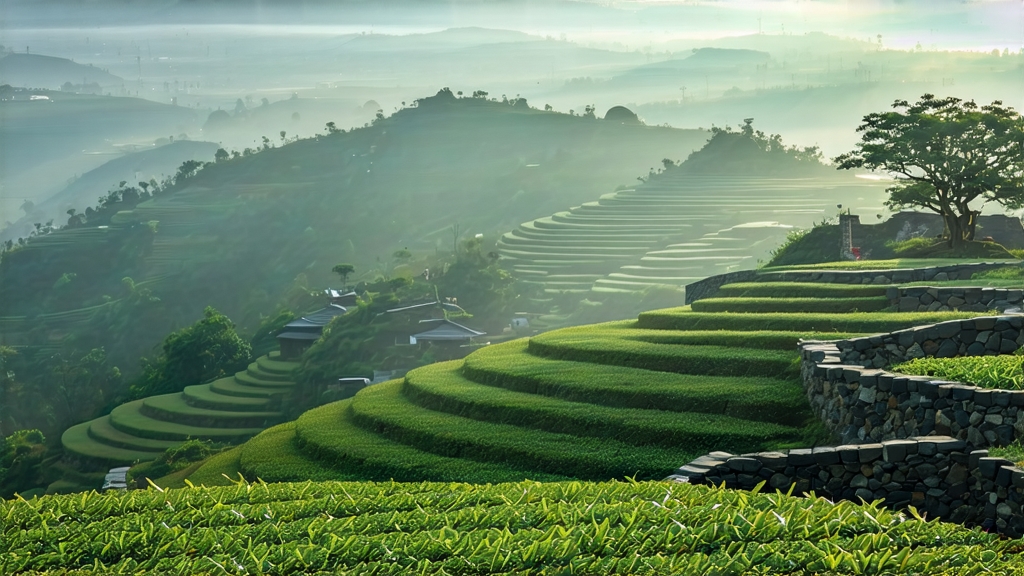
Tucked high above the Sichuan basin, where perpetual cloud veils the Min River gorge, lies Meng Ding Mountain, the cradle of the world’s oldest cultivated tea garden. It was here, in the mist-cooled terraces of Ganlu Temple, that Buddhist monks first coaxed a green bud into gold more than twelve centuries ago. The result—Meng Ding Huang Ya—became the palace favorite of Tang emperors, the first yellow tea ever entered into the register of imperial tributes in 724 CE. While later dynasties shifted fashion to roasted green and oxidized red, the secluded cliff gardens preserved the slow, secret “sealed yellowing” technique that still defines this rare category today.
Botanically, Meng Ding Huang Ya is a single-bud or one-bud-and-one-leaf picking of the local Sichuan small-leaf landrace, Camellia sinensis var. sinensis ‘Ganlu-1’. The cultivar is distinguished by downy, almost translucent buds that flush later than neighbors, accumulating extra L-theanine under cool mountain nights. Only the first twenty-four hours of spring growth—when the bud stands just 12–15 mm, still folded like a miniature bamboo shoot—qualify for the grade called “Imperial Sparrow Tongue.” A second grade, “Gold Slice,” adds the immediate next leaf, but plucking ends when the sun clears the ridge, for warmth accelerates lignification and destroys the silken texture.
The craft begins with a gentle wither on bamboo trays set inside the temple’s stone courtyards. Monks once chanted sutras while turning the leaves, believing mantra harmonized moisture loss; today, electric fans mimic the same 55 % relative humidity, yet the rhythm—thirty minutes of rest, five minutes of toss—remains unchanged. Next comes the “killing green,” but at lower temperature (140 °C) and shorter duration (ninety seconds) than green tea, preserving internal enzymes critical for the hallmark yellowing. A master’s bare hand is the thermometer: when buds feel like warm silk yet emit no grassiness, the kettle is sealed.
What follows is the step that gives yellow tea its name: men huang, literally “sealed yellowing.” The parched buds are wrapped, still steaming, in thick hand-woven cotton bundles the size of a monk’s alms bowl. These bundles are stacked inside a lacquered wooden chest lined with wet camphor leaves; temperature holds at 34 °C, humidity at 85 %. Over the next six to eight hours, non-enzymatic oxidation and Maillard reactions turn chlorophyll into pheophytin, catechins into theaflavins, and release a cascade of chestnut, orchid, and honey notes. Every ninety minutes the chest is opened, bundles unrolled, buds gently fluffed, then re-sealed—an act compared to “rocking a child back to sleep.” The cycle repeats for three nights, reducing moisture to 20 % and turning the leaf an even, lustrous golden maize.
A final low-temperature bake (60 °C) locks in fragrance without adding roast, after which the tea rests for one moon phase so residual heat and moisture equilibrate. When done perfectly, the dry leaf resembles a miniature golden spear: straight, evenly colored, and so downy it feels like stroking a cat’s ear. Fifty grams require roughly 24,000 buds—an entire day’s pick from three experienced pluckers—explaining why fewer than three metric tons of authentic Meng Ding Huang Ya reach market each year.
To brew, choose a tall, thin-walled glass or a 120 ml gaiwan; transparency allows observation of the “three rises and three falls,” a dance unique to downy buds. Water should be mountain-spring soft, 85 °C at first infusion, 88 °C thereafter. Use one gram of leaf per 20 ml, rinsing for only five seconds to awaken the bud without washing away down. The first steep, thirty seconds, releases a pale chardonnay liquor and an aroma that connoisseurs liken to “orchid growing through warm brioche.” Sip, letting the liquor coat the upper palate; a cooling sensation appears behind the molars, a signature of high-theanine buds. Second infusion, twenty seconds, deepens color to old gold and adds notes of sweet corn milk. By the fourth, when leaves have fully stood upright like soldiers on parade, a faint alpine stone-fruit note emerges, reminiscent of wild Chinese apric